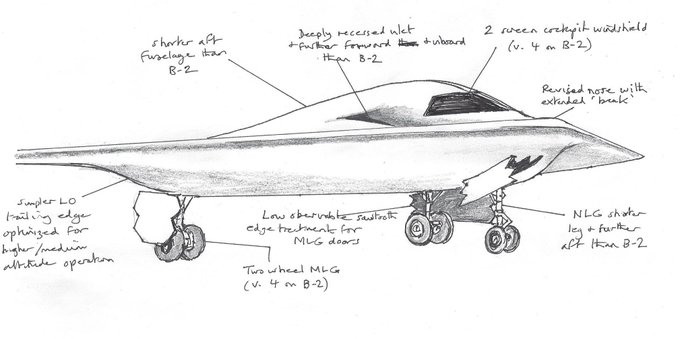The B-21 Bomber Is the Coolest Plane We’ve Never Seen
The B-21 Raider will be the service’s first new bomber in more than 30 years.
 NORTHROP GRUMMAN
NORTHROP GRUMMAN
- The U.S. Air Force and Northrop Grumman released the first new images of the B-21 Raider in nearly four years.
- The bomber is similar to the B-2A Spirit but subtle differences hint at some major changes.
- The B-21 Raider is expected to fly for the first time sometime in 2022.
The U.S. Air Force and Northrop Grumman have released the first new image of the B-21 Raider bomber in nearly four years. The image, designed to show the plane in hangars at air bases across the country, shows a few more details of the stealthy bomber. According to aviation experts, the new plane looks like the B-2 bomber with some key differences.
The images were shared by Northrop Grumman, the prime contractor on the B-21 Raider program. The three images show the plane sitting in hangars at Ellsworth Air Force Base in South Dakota, Whiteman Air Force Base in Missouri, and Dyess Air Force Base in Texas. Ellsworth and Dyess are currently home to B-1B Lancer bombers while Whiteman is home to America’s fleet of B-2A Spirit bombers. The B-21 Raider will eventually replace both types.

The first image of the B-21 Raider unveiled in 2016. Some details, such as the prominent nose or beak, were not as apparent as they are in the new images.U.S. AIR FORCE
The B-21 Raider is the first new Air Force bomber since 1988, the year the B-2A Spirit was unveiled. Named after “Doolittle’s Raiders,” the force of B-25 Mitchell bombers that bombed Tokyo in the Spring of 1942, the B-21 is designed to overcome modern air defense threats, including such systems as the Russian S-400 surface-to-air missile system and Chinese J-20 stealth fighter to penetrate enemy airspace. The B-21 will be capable of carrying precision-guided conventional missions and nuclear weapons.

The B-21 will be a flying wing design, a specialty of Northrop Grumman’s since the end of World War II. The blending of the fuselage and wing, combined with the lack of horizontal and vertical stabilizers in the rear, is generally thought of as the best shape possible to avoid enemy radars from all directions. A bomber penetrating deeply into enemy territory will likely have radar waves bouncing off it from multiple angles, making all-around stealth a necessity.ADVERTISEMENT – CONTINUE READING BELOW
The new images sparked some conversation, as reporters and aviation enthusiasts discussed the new plane’s features. Here’s a sketch of the B-21 with notes by reporters from Aviation Week & Space Technology:Guy Norris@AvWeekGuy
@TheDEWLine and I take a stab at likely design changes on B-21 v B-2 after @northropgrumman @usairforce release new rendition. https://aviationweek.com/defense-space/new-b-21a-renderings-reveal-diminutive-size-compared-b-2a … and here’s our 1st version…

The aviation blog The Aviationist also took a stab at analysis of the photos, which you can see here.
Overall, the trend for the B-21 is a refinement of the B-2A’s original flying wing shape. The leading edge shape of the B-21 is simpler than the B-2A’s sawtooth trailing edge. The cleaner, simpler trailing edge is probably how the original stealth bomber was supposed to look, but in the 1980s a last-minute demand by the Air Force that the Spirit be capable of low-altitude flight necessitated an expensive design change. As a result, as Aviation Week’s analysts point out, the plane is likely optimized for medium- and high-altitude flight.

The B-2’s trailing edge is more pronounced than the B-21’s, as a result of a need to strengthen the plane against the stresses of low-altitude flight.JEROD HARRISGETTY IMAGES
Experts believe the B-21 will be smaller than the B-2A, running about two-thirds the size and weight of the older bomber. This is reflected in the fact that the B-21 rendering features fewer main landing gear wheels. The aircraft simply needs fewer landing wheels to support a lighter airplane. Aviation Week points out that the rendering displays a shorter fuselage and air inlets farther forward than the older bomber. This is all to increase internal volume for crew life support, fuel, sensors, and weapons. As a stealthy airplane, the B-21 must store all weapons, sensors, fuel, and other items internally, so space is at a premium.
The U.S. Air Force plans to buy at least 100 B-21 Raiders for $550 million each in 2012 dollars, or about $654 million in 2020 dollars. Ideally, the service would like 200 or more. The aircraft is currently under development at Northrop Grumman’s facilities in Palmdale, California, with the first demonstrator aircraft in the construction phase. The bomber was originally supposed to fly in late 2021, but that date will likely slide into early 2022.
Source: Kyle Mizokami Aviation Week and The Aviationist

Leave a Reply